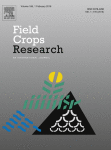Ver ítem
- xmlui.general.dspace_homeCentros Regionales y EEAsCentro Regional Buenos Aires SurEEA BarrowArtículos científicosxmlui.ArtifactBrowser.ItemViewer.trail
- Inicio
- Centros Regionales y EEAs
- Centro Regional Buenos Aires Sur
- EEA Barrow
- Artículos científicos
- Ver ítem
Grain yield, nutrient content and lipid profile of oat genotypes grown in a semiarid environment
Resumen
The objective was to evaluate oat cultivars for grain yield and quality in two years of different climatic conditions. Cultivars were chosen for forage yield, pest resistance or environmental stress tolerance. The study, in 2004 and 2005, included 15 cultivars of Avena sativa and three of Avena byzantina seeded in 1.4 by 5.5 m plots. One set of plots was managed for dual purpose (DP), and a second set was only for grain (GO). Total grain yield (GYLD) and
[ver mas...]
The objective was to evaluate oat cultivars for grain yield and quality in two years of different climatic conditions. Cultivars were chosen for forage yield, pest resistance or environmental stress tolerance. The study, in 2004 and 2005, included 15 cultivars of Avena sativa and three of Avena byzantina seeded in 1.4 by 5.5 m plots. One set of plots was managed for dual purpose (DP), and a second set was only for grain (GO). Total grain yield (GYLD) and hectolitre weight (HW) was determined for DP and GO, while grain samples from DP were analyzed for crude protein (CP); ether extract (EE), starch (STA), β-glucan (β-GLU), neutral detergent fibre (NDF), acid detergent fibre (ADF), acid detergent lignin (ADL) and fatty acid composition. Significant interactions of cultivars by year were found for all traits. Overall GYLD was 88% higher when oat was managed for GO. The highest yields within DP were for Bw 103, Canai, Pilar, Polaris, Rocío (2004) and U 16 (2005). For GO, cultivars Payé, Polaris and U 16 (2004) and Maja (2005), respectively showed the best yields. Overall and yearly means were numerically similar for HW within genotypes and management. Greater CP NDF, ADL, β-GLU variability was observed in 2004 compared with 2005. However ADF and STA did not appear to be influenced by year, with similar yearly means. For STA content, the most stable cultivars in both years were Milagros and Cristal, with STA values higher than 39%. For NDF and ADF concentration Tucana was the most stable cultivar. Cultivars Bw 103, Máxima and Rocío exhibited the highest β-GLU values in both years. The fatty acids palmitic, oleic and linoleic acids were 91% of total in both years with greater variability and mean content in 2004. Low to moderate but significant correlation coefficients were: STA with GYLD (R = 0.45), NDF (R = −0.41) and HW (R = 0.38); GYLD with β-GLU (R = 0.55) in 2004; and NDF with HW (R = −0.41) in 2005. The relationship found for EE and fatty acids were less affected by year, and the more relevant associations were: EE and oleic (R = 0.57), palmitic and estearic (R = 0.54), estearic and linolenic (R = 0.60) and oleic and linoleic (R = −0.72). All variables seem more influenced by environment than by genotype.
[Cerrar]

Autor
Martínez, Marcela F.;
Arelovich, Hugo Mario;
Wehrhahne, Nilda Liliana;
Fuente
Field Crops Research 116 (1–2) : 92-100 (March 2010)
Fecha
2010-03-03
Editorial
Elsevier
ISSN
0378-4290
1872-6852
1872-6852
Formato
pdf
Tipo de documento
artículo
Palabras Claves
Derechos de acceso
Restringido
 Excepto donde se diga explicitamente, este item se publica bajo la siguiente descripción: Creative Commons Attribution-NonCommercial-ShareAlike 2.5 Unported (CC BY-NC-SA 2.5)
Excepto donde se diga explicitamente, este item se publica bajo la siguiente descripción: Creative Commons Attribution-NonCommercial-ShareAlike 2.5 Unported (CC BY-NC-SA 2.5)

